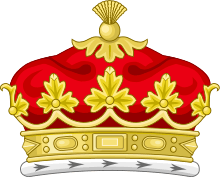Duke of Cambridge
| Dukedom of Cambridge | |
|---|---|
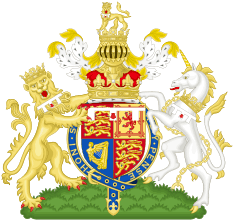 | |
| Creation date | 26 May 2011[1] |
| Creation | Fifth |
| Monarch | Elizabeth II |
| Peerage | Peerage of the United Kingdom |
| Present holder | Prince William |
| Heir apparent | Prince George |
| Remainder to | the 1st Duke's heirs male of the body lawfully begotten[1] |
| Subsidiary titles |
Earl of Strathearn Baron Carrickfergus |
| Status | Extant |
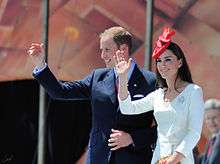
Duke of Cambridge, one of the six current royal dukedoms in the United Kingdom, is a hereditary title of specific rank of nobility in the British royal family. The title (named after the city of Cambridge in England) is hereditary among male agnatic descendants of the titleholder by primogeniture, and has been conferred upon members of the British royal family several times. The wife of the titleholder is usually called Duchess of Cambridge.
The title goes back to the 17th century, and superseded an earlier title of Earl of Cambridge. The title became extinct several times, before being revived after a hiatus of over a hundred years in 2011, when it was bestowed upon Prince William on 29 April 2011 upon his marriage on the same day to Catherine Middleton.
History
The title was first granted to Charles (1660–1661), the first son of the Duke of York (later King James II), though he was never formally created Duke of Cambridge because he had died at the age of six months. The first officially recognised creation of the dukedom was in the Peerage of England in 1664, when James Stuart, second son of the Duke of York, was granted the title, but he died early in 1667 at the age of three, and the title again became extinct. The title was then granted later that year to the third son of the Duke of York, Edgar, but he then died in 1671 at the age of three, and the title again became extinct. The Duke of York's eldest son by his second wife, Charles, was also styled Duke of Cambridge in 1677, but died when about a month old, not having lived long enough to be formally created duke.
The title was recreated in 1706 and granted to George Augustus, son of the Elector of Hanover (later King George I). When George Augustus ascended to the throne as King George II in 1727, the dukedom merged with the crown.[2]
The title was again recreated and given, in the Peerage of the United Kingdom, to Prince Adolphus, the seventh son of King George III.[3] The title was inherited in 1850 by his only son, Prince George. George had three sons, but they were barred from inheriting the title as his marriage was in violation of the Royal Marriages Act 1772, so that upon his death in 1904, the title again became extinct.[4]
During the period leading up to the 1999 wedding of Prince Edward, the youngest son of Queen Elizabeth II, experts speculated that the dukedom of Cambridge or Sussex were the most likely to be granted to him, and The Sunday Telegraph later reported that Prince Edward was at one point set to be titled Duke of Cambridge.[5] Instead, Prince Edward was created Earl of Wessex, and it was announced that he would eventually be created the next Duke of Edinburgh after his father.[6]
On 29 April 2011, the day of his wedding, it was announced that Prince William was to be created Duke of Cambridge, Earl of Strathearn and Baron Carrickfergus.[2] The letters patent granting these titles received the great seal on 26 May 2011.[1]
Dukes of Cambridge
Styled, 1660
| Duke | Portrait | Birth | Marriages | Death |
|---|---|---|---|---|
| Charles Stuart House of Stuart 1660–1661 |
no portrait | 22 October 1660 Worcester House, London son of King James II and Anne Hyde |
not married | 5 May 1661 Whitehall Palace, London aged 6 months |
First creation, 1664
| Duke | Portrait | Birth | Marriages | Death |
|---|---|---|---|---|
| James Stuart House of Stuart 1664–1667 also: Earl of Cambridge and Baron of Dauntsey (1664) |
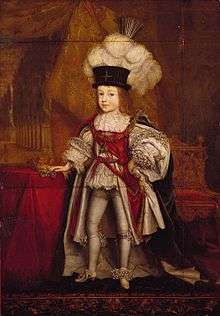 |
12 July 1663 St James's Palace, London son of King James II and Anne Hyde |
not married | 20 June 1667 Richmond Palace, London aged 3 |
Second creation, 1667
| Duke | Portrait | Birth | Marriages | Death |
|---|---|---|---|---|
| Edgar Stuart House of Stuart 1667–1671 also: Earl of Cambridge and Baron of Dauntsey (1667) |
no portrait | 14 September 1667 St James's Palace, London son of King James II and Anne Hyde |
not married | 8 June 1671 Richmond Palace, London aged 3 |
Styled, 1677
| Duke | Portrait | Birth | Marriages | Death |
|---|---|---|---|---|
| Charles Stuart House of Stuart 1677–1677 |
no portrait | 7 November 1677 St James's Palace, London son of King James II and Queen Mary |
not married | 12 December 1677 St James's Palace, London aged 35 days |
Third creation, 1706
| Duke | Portrait | Birth | Marriages | Death |
|---|---|---|---|---|
| Prince George House of Hanover 1706–1727 also: Marquess of Cambridge, Earl of Milford Haven, Viscount Northallerton and Baron Tewkesbury (1706–1714); Prince of Wales (1714), Duke of Cornwall (1337) and Duke of Rothesay (1398) |
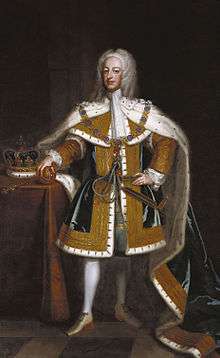 |
30 October / 9 November 1683O.S./N.S. Herrenhausen, Hanover son of King George I and Sophia Dorothea of Celle |
22 August 1705 Caroline of Ansbach 10 children |
25 October 1760 Kensington Palace, London aged 76 |
| Prince George succeeded as George II in 1727 upon his father's death, and his titles merged with the crown. | ||||
Fourth creation, 1801
| Duke | Portrait | Birth | Marriages | Death |
|---|---|---|---|---|
| Prince Adolphus House of Hanover 1801–1850 also: Earl of Tipperary and Baron Culloden (1801) |
24 February 1774 Buckingham Palace, London son of King George III and Queen Charlotte |
18 June 1818 Princess Augusta of Hesse-Kassel 3 children |
8 July 1850 Cambridge House, London aged 76 | |
| Prince George House of Hanover 1850–1904 also: Earl of Tipperary and Baron Culloden (1801) |
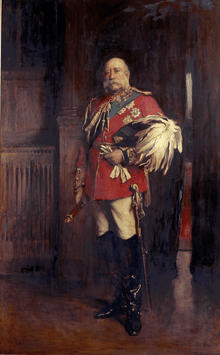 |
26 March 1819 Cambridge House, Hanover son of Prince Adolphus and Princess Augusta |
8 January 1847 Sarah Fairbrother 3 children |
17 March 1904 Cambridge House, London aged 84 |
| Prince George's marriage to Sarah Fairbrother produced three sons. However, due to the Royal Marriages Act 1772, the marriage was invalid and all his titles became extinct on his death. | ||||
Fifth creation, 2011
| Duke | Portrait | Birth | Marriages | Death |
|---|---|---|---|---|
| Prince William House of Windsor 2011–present also: Earl of Strathearn and Baron Carrickfergus (2011) |
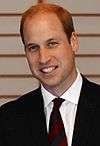 |
21 June 1982 St Mary's Hospital, London son of Prince Charles and Lady Diana Spencer |
29 April 2011 Catherine Middleton 3 children |
– now 36 years, 118 days old |
Future dukes
If Prince William dies before becoming king, then his sons are eligible to inherit the dukedom:
- Prince George of Cambridge (born 2013)
- Prince Louis of Cambridge (born 2018)
Family tree
See also
References
- 1 2 3 "No. 59798". The London Gazette. 1 June 2011. p. 10297.
- 1 2 "Announcement of Titles: Statement issued by the press secretary to The Queen". The Royal Household. 29 April 2011. Archived from the original on 30 April 2011. Retrieved 2012-04-30.
- ↑ "No. 15429". The London Gazette. 21 November 1801. p. 1403.
- ↑ Tim Ross (16 November 2010). "Could William and Kate be the next Duke and Duchess of Cambridge?". The Telegraph. telegraph.co.uk. Retrieved 11 February 2012.
- ↑ Richard Eden (12 December 2010). "Royal wedding: Prince William asks the Queen not to make him a duke". The Telegraph. telegraph.co.uk. Retrieved 12 December 2010.
- ↑ "The Earl of Wessex-Styles and Titles". The Royal Household. Archived from the original on 3 March 2016. Retrieved 30 April 2012.
